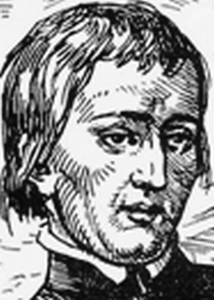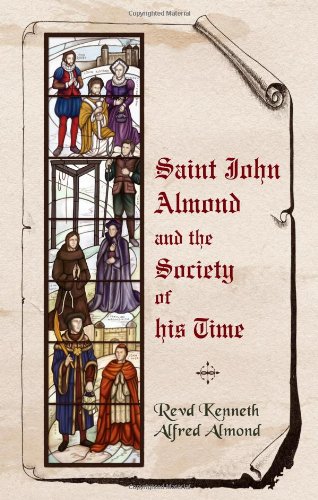John Almond (or, aka Lathom or Molyneux, his aliases when incognito) was born at Allerton near Liverpool of Catholic parents about 1565, a time when being a Catholic was against the law. John spent much of his childhood in Allerton, near Liverpool, and at Much Woolton in Lancashire for his school years, before moving to Ireland with his parents where he was to finish his education and stay until reaching adulthood.
He then went on to study in Reims, France, where he pursued his vocation into the priesthood.
At the age of 20 he went to the English College in Rome where he would be ordained into the priesthood in1598 and then returned to the dangers of England as a missionary priest in 1602. Remembered as a great public debater, it was during the end of his time in Rome that he gave a public defense of theses that cover the whole course of philosophy and theology, and known as the “Grand Act” which was warmly congratulated by Cardinal Caesar Baronius and Cardinal Francesco Maria Tarugi.
John’s love for his homeland and his fellow English Catholics made him eager to return and once there he travelled from house to house, village to village and town to town ministering to Catholics and sternly defending the Catholic Faith to those that opposed or questioned him. Saint John Almond never tired of trying to win back Protestants to the Catholic creed through his discussion and modesty.
Saint John Almond continued to minister to the faithful and labored in his mission for 10 years, during that time he would eagerly speak out against the anti-Catholic powers of the state.
He was first arrested for his papist behaviour in 1608, and then again in 1612 for high treason on account of his priesthood. He had many debates with the Anglican authorities that would try to convince him that the Catholic Church was wrong but they soon found that Saint John Almond was unbeatable in discussions on the subject. This lead to him gaining many enemies in the higher Anglican clergy, including Dr King, the Protestant bishop of London.
It was during the November of 1612 that seven priests made good their escape from prison. The successful escape was considered to infuriate the Catholic persecutors and it was the Protestant bishop of London, Dr King, who was most irritant at John Almond. Thus it was on the 5th December 1612 that Saint John Almond was taken to Tyburn to be hung, drawn and quartered.
He was known as a ‘reprover of sin’ and many considered him as a good example to follow because of his ingenious and acute understanding, sharp and apprehensive in his conceits and answers, yet complete with modesty. Saint John Almond was full of courage and was ready to ‘suffer for Jesus Christ, who had suffered for him’. He courageously displayed modesty and humbleness and died with the name of Jesus upon his lips.
He refused to sign the Oath of Allegiance in the form in which it was offered him, but offered to swear that he bore in his heart “so much allegiance to King James as he, or any Christian king, could expect by the law of nature, or the positive law of the true Church, be it which it will, ours or yours.”
He was committed to Newgate and within a few months was brought to trial as a seminary priest. Having been duly convicted he was hanged, drawn, and quartered on 5 December 1612 at Tyburn, London.
On the scaffold he flung some seven or eight pounds in silver, with his (rosary)beads, his points(?), and his (penetential/uncomfortable garment) discipline, for those to get them who would, and gave to the hangman an angel, not to spare him, but to treat him as he should.
He had come hither, he said, to shed his blood for his Savior’s sake, Who had shed His blood for his sins. In which respect he wished that every drop that he would shed might be a thousand ; that he might have St. Lawrence’s gridiron to be broiled on, St. Peter’s cross to be hanged on, St. Stephen’s stones to be stoned with, to be ript, ript, ript, and ript again.
Then, being in his shirt, he kneeled down, and often repeating “In manus tuas, Domine, &c.”—“Into Thy hands, O Lord, I commend my spirit ”—he waited till the hangman was ready, without any sign of fear; but, ever smiling, he protested he died chaste, but not through his own ability or worthiness, but by Christ’s special grace, and that he ever hated those carnal sins, for which the Catholic religion had been slandered.
At last, the cart was drawn away, and with the words “ Jesu, Jesu,” his soul flew to Him for Whom he shed his blood, Tyburn, December 5, 1612.
“To use this life well is the pathway through death to everlasting life.”
–St. John Almond
Love,
Matthew


